#Neuroscientific
Text
“Sentience: The Invention of Consciousness” with Professor Nicholas Humphrey
Introduction: Human existence is intricately tied to our capacity for consciousness, a phenomenon that forms the bedrock of self-awareness. Professor Nicholas Humphrey, a distinguished neuropsychologist, explores the origins and evolutionary history of consciousness in his seminal work, "Sentience: The Invention of Consciousness." This article delves into the key concepts presented in the book, examining the transition from cognitive to phenomenal consciousness, the adaptive nature of consciousness in living organisms, and the intriguing possibility of consciousness emerging in artificial entities.
Exploring Cognitive Consciousness: Humphrey's work delves into the realm of cognitive consciousness, raising thought-provoking questions about how early animal ancestors possessed this cognitive awareness and how it subsequently evolved into phenomenal consciousness. The inquiry extends to identifying potential thresholds, such as neuron count, processing capacity, or brain size, that played a role in this evolutionary development. A central query emerges: can consciousness transcend organic life and find expression in artificial intelligence?
The Characteristics of Consciousness: Consciousness, as Humphrey elucidates, is intricately tied to short-term memory and can manifest independently of sensory inputs. It exhibits a remarkable capacity for attention and the ability to entertain alternative interpretations of complex or ambiguous data. Such attributes underline the significance of consciousness in shaping our perception and understanding of the world.
The Neuroscientific Correlation: Neuroscientists have made strides in correlating specific brain activities with corresponding subjective experiences. From feelings of hunger to pleasure and pain, there exists a discernible connection between certain types of brain activity and conscious awareness. This correlation provides a foundational understanding of the neural underpinnings of consciousness.
The Emotional Roots of Consciousness: Contrary to traditional views, Humphrey suggests that consciousness may not have evolved solely for the purpose of creating internal representations of the external world. Instead, he posits that consciousness may be an extension of primitive emotional influences. These emotional stimuli, originating from primordial instincts, prompt a response in organisms, preparing their brains for adaptive actions.
The Development of Conscience: A captivating question emerges: when did humans develop a conscience? Archaeological consensus places this pivotal moment approximately 45,000 years ago, marking a cultural evolution towards modernity. This milestone raises intriguing inquiries into the interplay between consciousness and moral awareness in shaping the human experience.
Conclusion: In Professor Nicholas Humphrey's exploration of consciousness in "Sentience: The Invention of Consciousness," a nuanced understanding of the evolutionary and cognitive aspects of consciousness emerges. This article has sought to distill the key themes from the book, offering a glimpse into the profound implications of consciousness on human existence, its potential manifestation in artificial entities, and its intricate connection with our emotional and moral landscape.
#Sentience#Research#Topic#ResearchMethods#Consciousness#Invention#NicholasHumphrey#Author#Neuroscientific#Cognitive#Emotional#Development#Awareness#SelfAwareness#Neuropsychologist#CognitiveConsciousness#Brain#ArtificialIntelligence#Adaptive#Archaeological#Cultural#Humans#Book#Volga#VolgaCanKaya
1 note
·
View note
Text
Exploring the Mind-Body Connection: Insights from Yoga and Neuroscience
Discover how the ancient wisdom of yoga sutras and the insights from modern neuroscience can deepen your understanding of the mind, consciousness, and the intricate connection between our inner selves and the external reality we perceive.
Exploring the Mind-Body Connection: Insights from Yoga and Neuroscience
Exploring the Mind-Body Connection: Insights from Yoga and Neuroscience
Have you ever wondered about the intricate relationship between the mind and the body? How does our consciousness perceive and interact with the world around us? In this blog post, we’ll delve into a fascinating neuroscientific study based on the…

View On WordPress
#ancient wisdom#annabackacupuncture#consciousness#malibu#mind#mind-body connection#modern research#neuroscience#neuroscientific perspective#ogden#pain#Patanjali#san pedro#Sankhya philosophy#south shores#transformative power#wellness#yoga#Yoga Texts Corpus#yogic journey
2 notes
·
View notes
Text
#Aromatherapy science#brain health#cognitive enhancement#essential oils#GABA receptors#mental wellness#natural anxiety relief#Natural Health Solutions#natural mood enhancers#neurological benefits of aromatherapy#neuroscientific research#olfactory system#stress management#therapeutic aromatherapy#homeopathy
0 notes
Text
Also my school wants to start training teachers on ABA and I am preparing myself mentally to explain to my supervisor that giving vaguely to outright ableist people a tool like ABA that has been used to abuse autistic kids is maybe the not move
#one of my fellow sped teachers#literally said#that he doesnt like the idea of autistic kids in a “school like ours”#because they dont know how to interact with ppl or something#like what????#and were supposed to be the advocates and supports for these kids#im a fucking AuDHD teacher getting an EdD in neuroscientific implications on education#dont fuck with me!!!!!
0 notes
Text
Shamanism: A Journey Through the Mind, Body, and Spirit Connection
Shamanism, a spiritual practice that spans across various cultures and epochs, serves as a profound testament to the universality of human psychobiological experiences. Through the lens of Winkelman’s (2002) research, we can understand shamanism not merely as a cultural artifact but as a manifestation of innate brain processes, representational systems, and psychophysiological dynamics inherent…
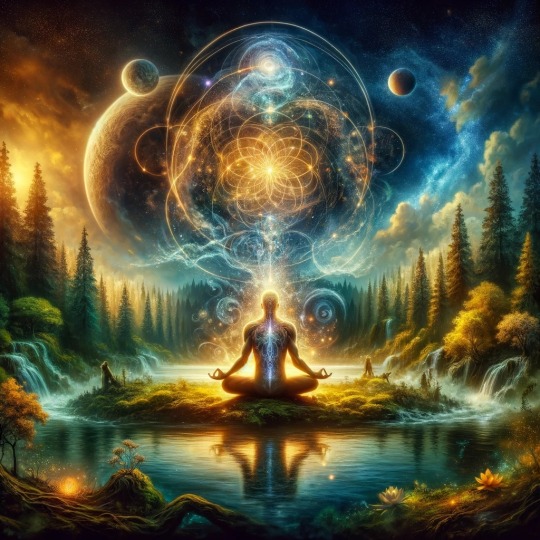
View On WordPress
#altered states of consciousness#ancestral spirits#consciousness studies#cross-cultural spirituality#healing rituals#inner realms exploration#metaphysical insights#mind-body connection#neuroscientific research on meditation#psychobiological processes#psychophysiological dynamics#ritual practices#shamanism#spiritual entities#spiritual healing#spiritual journey#symbolic representation#transcendent experiences#universal human experiences#Winkelman shamanism research
0 notes
Text
India's Foray into BCI
India's Foray into BCI
@neosciencehub
#neosciencehub #science #BCI #braincomputer #neuralink #neurotechnology #IITKharagpur #technology #human #brain #BCISystems #India #research #scholars #IITPalakkad #IndianNeuroscientificInnovation #Rehabilitation
India’s contribution to the rapidly evolving field of brain-computer interfaces (BCIs) is a testament to the nation’s burgeoning interest and capabilities in neurotechnology. With various institutions and research groups leading the way, India is positioning itself as an active participant in the global BCI landscape.
Debasis Samanta: Bridging Technology & Accessibility
Dr. Debasis Samanta’s…

View On WordPress
#Assistive Technology India#BCI Development India#Brain Computing Accessibility#Brain-Computer Interface India#EEG Driver Drowsiness Detection#featured#IIT Kharagpur BCI#IIT Palakkad Neuroscience#Indian Neuroscientific Innovation#Neurotechnology Research#Rehabilitation Technology#sciencenews
0 notes
Text
🎭 Life as a Dream: Unraveling the Tapestry of Perception and Reality 🎭
🌠 Dive into the Intrigue of Illusion
Have you ever stopped to ponder if our perceived reality might merely be a well-crafted illusion? An intricate dream from which we might never wake? While it may sound like a plotline pulled straight out of a science fiction novel, this thought-provoking concept has been at the heart of philosophical and spiritual discussions for ages. So, let’s delve into…

View On WordPress
#dream#Existence#Illusion#Maya#Neuroscientific Research#Perception#personal growth#Phenomenology#Philosophy#reality#Solipsism#Subjectivity
1 note
·
View note
Text
as we see skyrocketing amounts of legislation targeting trans youth in particular I’m begging people to stop parroting “your brain matures at 25”. this article by the director of harvard’s neuroscience lab is a good read. like I’m no neuroscientist myself but Brain Complicated. at best “your brain matures at 25” is an incomplete and inadequate summary of a single idea in a relatively new field wherein broad generalizations are almost impossible. *some* aspects of brain development *tend* to *plateau* *somewhere* in your 20s, *we think*; but “brain maturity” is poorly defined, and the data is still highly incomplete. plenty of aspects of the brain demonstrably continue developing well past 30, or for your entire life; on the other hand, plenty of studies have simply failed to include participants over 30, or 25, or even younger. attempting to define maturity, let alone make RULES about it, based on particular neuroscientific metrics, is extremely dicey
and this popsci notion is now actively being used to justify taking away people’s rights so pls stop perpetuating it for the sake of your age gap ship wars or whatever
#text#that article also does a good job of clarifying the ‘adolescents can’t do forethought and rationality’ stereotype
15K notes
·
View notes
Text
"It doesn't matter how much of a 'neuroscientific breakthrough' it is. Using arbitrary code execution to re-code a patient's brain into Pong is definitely malpractice!"
4K notes
·
View notes
Text
Exploring the Mind-Body Connection: Insights from Yoga and Neuroscience
Discover how the ancient wisdom of yoga sutras and the insights from modern neuroscience can deepen your understanding of the mind, consciousness, and the intricate connection between our inner selves and the external reality we perceive.
[https://www.ncbi.nlm.nih.gov/pmc/articles/PMC8675243/]
Exploring the Mind-Body Connection: Insights from Yoga and Neuroscience
Have you ever wondered about the intricate relationship between the mind and the body? How does our consciousness perceive and interact with the world around us? In this blog post, we’ll delve into a fascinating neuroscientific study based on the perspective on the…

View On WordPress
#ancient wisdom#consciousness#mind#mind-body connection#modern research#neuroscience#neuroscientific perspective#Patanjali#Sankhya philosophy#transformative power#yoga#Yoga Texts Corpus#yogic journey
0 notes
Text
I'm Roomba cleaning again, complicated by the fact that I'm also taking down and packing away the decorations from Christmas, and since I change things/buy things/get rid of things every year while I try to fine-tune my decorations, that also means packing them away is more complicated than when I was a kid and it was like "here are our 5 boxes of Christmas decorations that will be the same until we die."
So I get to feeling frustrated and scattered because no one thing is coming together, because I keep going "oh shit, laundry. Okay, now that I'm in the laundry room, let's grab these Christmas sheets I cleaned and set aside a week ago and see if they fit in the new sheet organizer I got. Okay, now that the sheets are in the organizer, they have to go in the closet. Okay, now I'm standing in front of the closet and oh look there's a thing I need to carry back out to the living room." And it feels like nothing like happening, but I can TELL it is. If I give myself an ounce of credit, I can see that I'm getting closer and closer to the house looking the way I want it to.
It just sucks! I just hate having the ADD. Like, on the one hand, what is ADD, how do we define it, what useful characteristics does the definition have, how will our understanding of this change as our base of behavioral neuroscientific knowledge increases over time, but also: there's something different about how my brain works and it's times like this I wish there wasn't!
#I am NOT ASKING for anyone to attempt to ANSWER those questions#they are RHETORICAL#I know more about ADD than the vast majority of tumblr users ever will#I'm saying that NO ONE knows ENOUGH about ADD#and that is why science is important#so for the love of GOD don't show up in the replies and reblogs like actually did you know you have ADD? YES I AM AWARE
55 notes
·
View notes
Text
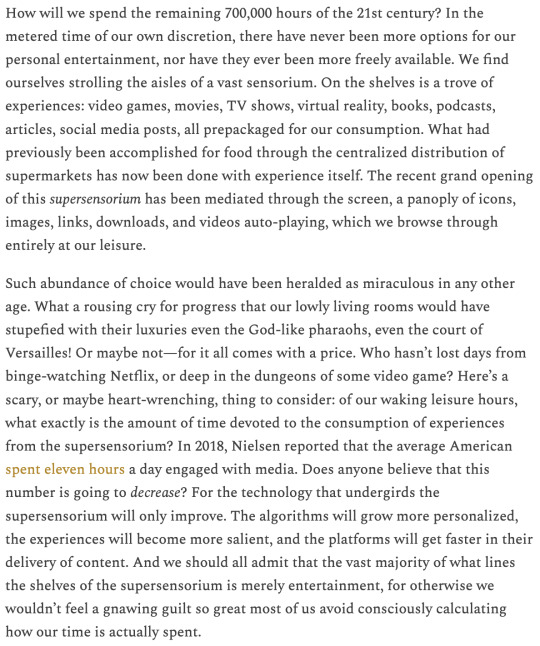
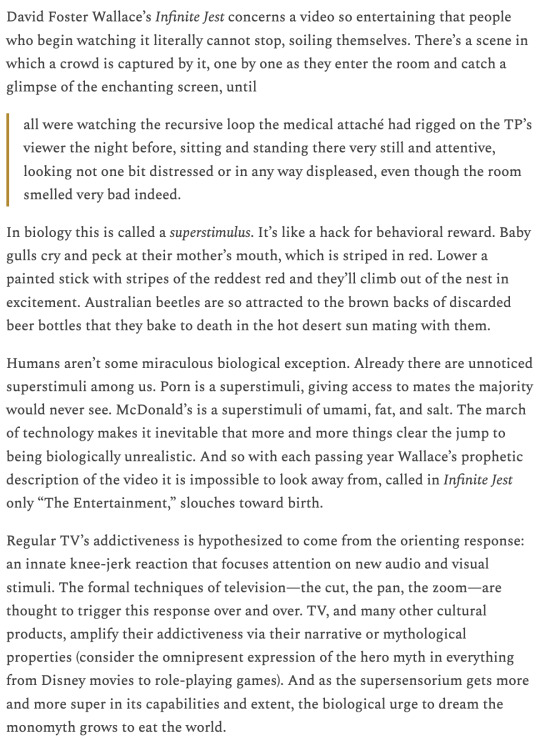
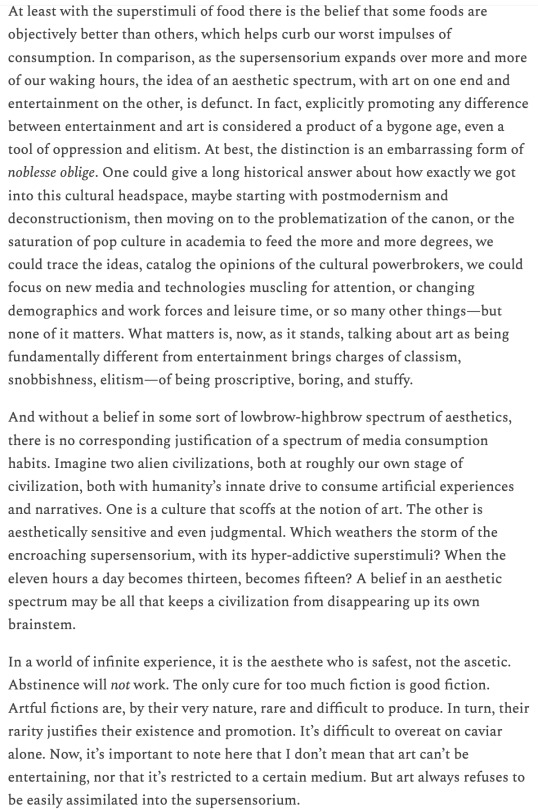

Exit the supersensorium, Erik Hoel, 2022
The neuroscientific case for art in the age of Netflix
#Been mulling over this for a bit#Just some excerpts! definitely deserves a full read#Adore the first sentence
219 notes
·
View notes
Note
Heyyy! I just wanted to first say I love your page it is absolutely a happy place for me tbh and I love the interactions you post. That being said, body language anon caught my attention in their last ask when they spoke about lestappen’s passion for the sport and f1 as an institution and would like to add some thoughts from a social-psychological pov.
I have also been thinking a lot about why lestappen stands out to many of us and why and how we got here and I think body language anon gets it right about how rather than big loud moments it is the smaller things that is so engrossing about their interactions. An account on tik tok (i have tried but can’t find it now) posted about how lestappen is “female gaze coded” precisely because of the little details (the boots, waits grab, shared history that is actually fanfiction worthy material). It is the purity and the meaningfulness of their interactions that make them so special rather than having two guys who are very obviously overzealous in their interactions (which has its appeals but clearly not to us- we like the angst and enemies to lovers trope too much for that)
Now from a socio-psychological standpoint I really want to take shipper goggles off for a moment and look at their relationship in their specific environment and the importance of homosociality. Homosociality is a theory that refers to the relations of same sex individuals in a society or given institution that sets them apart from the other sex- and other instituons/groups. And added layer that is slipping into Freudian territory-though I’m cautious- is that there is a latent homoerotic nature in same sex interactions- especially with men. This is not necessarily in a sexual way but more in a mutually reinforcing emotional way. Men in a give institution will seek the reinforcement of other men in their group and that is the crux of masculine homosociality and masculine relations- being self-reinforcing via socialisation with other men you hold in high regard due to their gender and their standing in the institution/group.
F1 as a male dominated institution and full of such reinforcing masculine interactions (driver-driver/TP/mechanics/fans (which is also why men find it hard to digest that women like F1 because they consider it an invasion of their sphere)) within this little system max and Charles have carved out special roles for one another where they seem to both especially seek out reinforcement from the other precisely because of that special shared passion for the sport and most likely because they both consider themselves above the rest of the men in the institution but equal and the same to one another which is why they seek each others reinforcement which can be literally anything that conveys approval (active listening, mirroring/mimicking, referencing shared history, accepting/initiating touch, laughing at jokes). There are some videos especially of Max in post race interviews where he looks almost jealous of Charles talking to another driver-and giving another driver the approval that belongs to Max. It becomes childish at that point with Max likely acting in a way that indicates his want to re-establish his special position with Charles- this may be by making jokes, eye contact or anything else which would result in instant approval. I can go into neuroscientific reward processes associated with seeking approval being equivalent to a drug and the best way to describe it is that if one of them shows any approval to the other it hits literally like neurotropic crack precisely because of the nature of their institutions and the special position of the other relative to themselves within that institution.
Which is also why I think that no matter how many times they interact publicly or privately they won’t ever have a relationship like Max and Daniel or Charles and Carlos where it is openly friendly and there is no slight tension (expressed by childish giddiness- like body language anon says with fidgeting and leg bouncing) caused by the fact that they have a long history that has carved out a specific place for the other driver as the approval-giver and becoming close friends would alter that dynamic to an un-acceptable degree. They will most likely alway remain flighty around each other, afraid of overstepping and messing up.
Anyway I’m sorry if this is messy this just popped into my head and I wanted to write it down.
Happy race weekend 🤍✨
Hello, my lovely anon! I'm going to refer to you as my beloved social-psychological anon, if that's alright with you.
First of all, thank you so much for your kind words. I'm so happy you're enjoying my blog, and that it's a happy place for you. That brings me so much joy to know. 💕
And babe, this anon has given me a beautiful start to my day. I've loved every single part of this ask, but this part right here is my personal favorite:
"There are some videos especially of Max in post race interviews where he looks almost jealous of Charles talking to another driver-and giving another driver the approval that belongs to Max. It becomes childish at that point with Max likely acting in a way that indicates his want to re-establish his special position with Charles- this may be by making jokes, eye contact or anything else which would result in instant approval." <<< Because this is the most spot-on thing I have ever read.
This social-psychologial insight into their relationship has truly added a whole other layer to Lestappen for me, and I don't think I could even begin to express to you how much I appreciate this. You and my body language anon are truly a beautiful combination, and I hope that you, like my body language anon, will return as often as you feel comfortable because it's such a wonderful treat to be able to read your insights.
Thank you so, so much for this, social-psychological anon. I love you.❤️
#Asks#Anon asks#Lestappen asks#Lestappen dynamics anons#Social-psychological anon#Lestappen gate 2023
91 notes
·
View notes
Note
"You rip them apart limb from limb with forceps or with a vacuum so powerful it pulls their body apart."
But they can't think or feel pain, so despite how awful that sounds, in the end no suffering is caused.
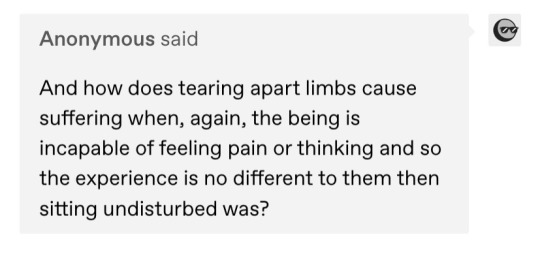
Current neuroscientific evidence indicates the possibility of fetal pain in the first trimester.
Ripping people apart is among the worst pain you can experience.
That means it can hurt.
55 notes
·
View notes
Text
Pioneering BCI : Journey Before Neuralink
Pioneering BCI : Journey Before Neuralink
@neosciencehub
#neosciencehub #science #neuralink #neurotechnology #neurotech #neuroscience #BrownUniversity #scientific #BCI #JohnDonoghue #braincomputer #research #BlackrockNeurotech #NSH #BrainImplants
The recent success of Neuralink in implanting a brain-computer interface (BCI) in a human brain has captured the world’s attention. However, it’s crucial to recognize that this achievement stands on the shoulders of numerous pioneering efforts in the field of neurotechnology. This article explores the significant contributions made before Neuralink that have shaped the current landscape of BCI…

View On WordPress
#BCI Breakthroughs#BCI Development#Blackrock Neurotech#Brain Implants#Brain-Computer Interface#featured#John Donoghue#Neuralink#Neurological Innovation#Neuroscientific Advancements#Neurotechnology Pioneers#Precision Neuroscience#sciencenews
0 notes
Text
The thing that people with power don’t know is what it’s like to have little or no power. Minute by minute, you are reminded of your place in the world: how it’s difficult to get out of bed if you have mental health conditions, impossible to laugh or charm if you are worried about what you will eat, and how not being seen can grind away at your sense of self.
I am often in rooms with people who do not understand this, people more educated than me, more privileged than me – people who are so accustomed to having power that they don’t even know it’s there. I am a black woman in my fifties, I am neurodiverse, and I have multiple mental health diagnoses. Part of my job as a researcher and cultural thinker involves working with leaders in the arts, business and politics, supporting them to see the one thing they can’t: the effects of the power that they wield.
But just pointing out this disparity can leave people feeling defensive. It can get you labelled an “angry black woman”. In the past, when I started to tell people about what it felt like to have no power, and how hard it was to understand, they didn’t listen. So I turned to science, to understand the effects of power in your body, in order to bring evidence to what I already knew, and make people listen.
I call this research the neurology of power. It involves looking at the sociological explanations of power as well as the neuroscientific underpinnings. Being in a state of powerlessness leads to perpetual stress. That stress trains our bodies to be on the alert for it, compromising our productivity and happiness in situations where others – those who have never experienced that sense of powerlessness – are left to thrive.
Anyone who’s ever taken a few deep breaths, forced themselves to lower their shoulders or closed their eyes to regain their composure is aware that the brain and the body are in a constant feedback loop. We feel our thoughts and we think our feelings.
Researching these ideas brought me into conversations with leading scientists around the world. Prof Lisa Feldman Barrett, at Harvard Medical School and Massachusetts general hospital, told me about a process known as “body budgeting”, or allostasis. She argues that, like a financial budget, our brains keep track of when we spend resources (eg going for a run) and when resources are deposited (eg eating). It is a predictive process, by which the brain maintains energy regulation by anticipating the body’s needs and preparing to satisfy those needs before they arise.
Feldman argues that this process is so fundamental to the architecture of the brain that it extends to our mental states. Our emotions arise from our brain’s calculations of the physical, metabolic needs of our bodies. Predicting a dangerous situation requiring us to flee results in physical changes and discomfort we register as anxiety.
This body budgeting has social effects. For instance, our ability to empathise with another person is dependent on our body budgeting. When people are more familiar to us, our brain can more efficiently predict what their inner state and struggles may be and feel like. This process is harder for those less familiar to us, so our brains may be less inclined to use up precious resources in making difficult predictions.
Sukhvinder Obhi, a professor of social neuroscience at McMaster University in Canada, told me more about how people with power often struggle to empathise with others. Because the brain makes predictions based on past experiences, these patterns are self-reinforcing. Often, powerful people learn to behave as if they have power. Powerless people learn to behave as if they have none.
This research legitimised what I always knew. Power wires the powerful for power; but it can also wire them against people without power. You can lose your empathy. And power is critical for wellbeing.
This empathy deficit has historically been a celebrated attribute among leaders – ruthlessness that allows people to make hard decisions without fear of the consequences. You can see it in political leaders of every political persuasion, from time immemorial. Today it feels particularly stark. It has left society divided, trust in powerful institutions eroded and policymaking driven by ideology rather than human experience.
We need a new kind of policymaking that puts people at the heart of the process. Policymakers need to start by listening, by sharing power with the people who really understand the nature of powerlessness and the effect of the policies they are writing. We can’t stay in this perpetual loop of those with power deciding everything. They are handicapped by their own privilege.
Many find this evidence about power uncomfortable to confront. I’ve spoken on panels, presented my arguments and had them disputed in public by senior academics, who later apologised privately, once they’d checked my references in full.
I shouldn’t need to lean on science to be heard and justify what I already know: that power is a limiting factor for our leaders and we need to make policy differently to counterbalance the power gap. This is a call to action: we can do things differently. Let’s try.
322 notes
·
View notes